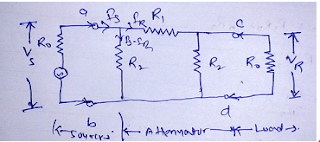Attenuator:-
An
attenuator is normally a four terminal network inserted between a source and load. It is introduced to incur a specific amount of loss for current and voltages.
In order to prevent attenuation distortion, all source frequencies must be
attenuated to the same degree and thus the network generally consists of purely resistive components.
Where,
= source voltage (V)
= load voltage (V)
= source current (A)
= load current (A)
= power input (WATT)
= power output (WATT)
= input impedance (Ω)
= output impedance (Ω)
Fonts For Facebook Generate cool and stylish fancy fonts for your Facebook account and Facebook Fonts you can use in all social media platform Fonts For FB
Attenuation:-
Power loss in any network represents attenuation it is conventional to express attenuation in terms of “neper” or “decibel (dB)”. The attenuation is defined by the square root ration of input power (PS) to the output power (PR).
Thus, attenuation = = (say)
N = =
N=
Similarly N in terms of voltage
N=
Where,
N indicates the level of attenuation. However, it is convenient to express attenuation in some unit i.e. decibel or neper, as indicated earlier. Attenuation (D)
D=
D =
Also D =
N = antilog (
Relation between decibel (dB) and neper (nep):-
As the attenuation dB is given by
D =
D =
D = 20 loge (N) 0.434
D = 8.686 loge (N)
Attenuation in dB = 8.686 Attenuation in Neper
Or
Attenuation in Neper = 0.1151 Attenuation in dB
- Classification of attenuators:-
Attenuators may be classified into two types such as symmetrical and asymmetrical attenuators.
It is a resistive network installed between source and load having equal input and output resistances (R1 = R2).
- Asymmetrical attenuator:-
It is also a resistive network installed between source and load having unequal input resistance. When looked into from the input and output terminals separately.
A resistive attenuator may be used for matching between circuits of different resistive impedances. The networks may, therefore, be used in place of a transformer.
Variable attenuators are used in laboratories for obtaining small values of voltage and current for testing purpose.
It is also used in a communication receiver for controlling of volume.
For high-frequency transmission.
It is also used to enhance the magnitude of the input impedance of an equipment or instrument.
- Analysis of asymmetrical T attenuator:-
It is one of the most common types of attenuators. The series arm impedance is given by R1 and shunts arm impedance by R2. A voltage source with internal resistance R0 is applied at the input ports (A-B) while the output (C-D) feeds a resistor (R0) equal to the characteristic impedance of T- network.
N = [ N = ] ………………….(1)
N-1 = ………………………..(2)
Assuming terminal a-b open, the input impedance looking through terminal a-b is given by
= (
=
= (
=
=
N =
N =
(N-1) =
=
= ………………..(3)
Putting the value of R1 in equation (2) and we get
(N-1) =
(N-1) =
=
= …………………….(4)
Equation (3) & (4) are called design equation of symmetrical T attenuator.
- Analysis of symmetrical type attenuator:-
Asymmetrical type attenuator it is also one of the commonest attenuators where. The series arm impedance is represented as R1 and the shunt arm impedance by R2. A voltage source with internal resistance R0 is connected at the input terminals (a-b) while the output is terminated its characteristic impedance R0.
The design procedure of the attenuator section consists of determining the value of R1 and R2 provided the value of R0 and attenuation (N) are given.
N = = N = = …………………………(1)
Reducing the - section for analysis
= …………………………(2)
Also for terminal g & d
= …………………….(3)
=……………………………(4)
Putting the value of & in equation we get
N = = = ……………………..(5)
N =
N-1 =………………………………….(6)
Assuming terminals (a-b) open
= (
=
=
=
Multiply numerator and denominator by
=
- Analysis of asymmetrical L attenuator working between two equal resistances.
Apply KVL in loop 2
R2 (IS – IR ) = IR Rt1
IS R2 = IR ( Rt1+R2 )
=
N R2 = Rt1+R2
R2 = ……………………………….(1)
Apply KVL in loop 1
VS = IS R1 + IR Rt1 [∵VS = IS Rt1 ]
IS Rt1 = IS R1 + IR Rt1
IS (Rt1 - R1) = IR Rt1
= = N
N Rt1 – N R1 = Rt1
R1 = Rt1 ………………………………(2)
- Design equation of L – type attenuator iterative impedance
Rt1 = R1 +
Rt1 (R2 + Rt1 ) = R1 R2 +R1 Rt1 +R2 Rt1
Rt1 =
Rt1 =
Rt1 =
- Analysis of an asymmetrical L-type attenuator for matching between two unequal resistances.
L attenuator is frequency needed for matching purpose. The design requires maximum attenuator along with impedance matching.
Ri 1 = …………………….(1)
Ri 2 = …………………….(2)
Where,
Ri 1 = Input resistance (image impedance) from terminal a-b keeping a-b open.
Ri 2 = Input resistance looking from terminal c-d keeping c-d open.
= R1 + R2 = R1
= R2 =
Ri 1 = = = ……………….(1)
Ri 2 = = …………………………..(2)
From equation (1)
Ri 12 =
R 2 = ………………………………..(3)
Putting value of R 2 in equation (2) we get
Ri22 =
= =
Ri22 = ………………………….(4)
Ri22 = ( -)2
= -
= Ri 1(Ri 1- Ri 2)
R1 = ………………………….(5)
Putting the value R1 in equation (4) we get
R 2 = =
R 2 = ………………………(6)
Equation (5) and (6) are called design equation of L attenuator working between two unequal resistances and behaving as impedance matching element.
Thought
“He, Who does not hope to win, has already lost……..So, Belief in yourself,. Work hard and than … you will emerge as a winner".
READ MORE:





Comments
Post a Comment